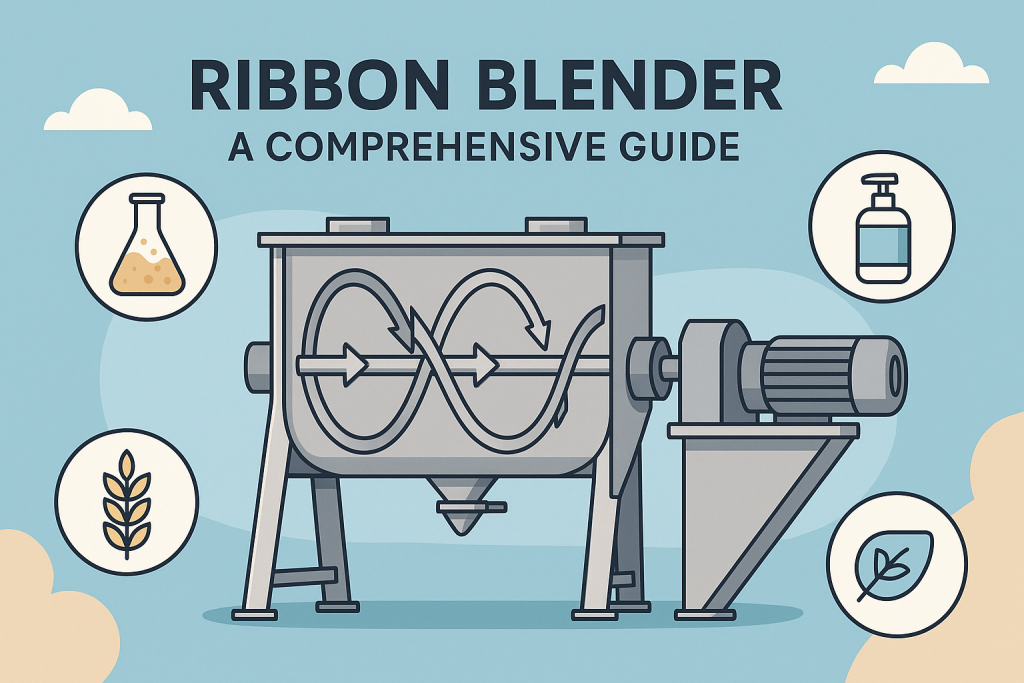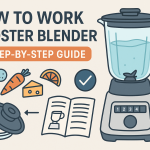In the world of industrial mixing and blending, the ribbon blender stands out as one of the most versatile and efficient machines. Known for its ability to thoroughly mix powders, granules, and even pastes, the ribbon blender is a cornerstone in industries such as food processing, pharmaceuticals, chemicals, cosmetics, and more. But what exactly is a ribbon blender, how does it work, and why is it so widely used? In this comprehensive guide, we’ll explore everything you need to know about ribbon blenders, from their design and operation to their benefits and applications.
What is a Ribbon Blender?
A ribbon blender is a type of industrial mixer designed for the homogenous blending of dry powders, granules, and viscous pastes. The machine consists of a horizontal U-shaped trough and a specially designed double helical ribbon agitator that rotates within the trough. As the ribbons move, they create a counter-current flow, ensuring all materials are thoroughly mixed.
Ribbon blenders are known for their simplicity, robust construction, and high efficiency in handling large volumes of mixable materials. They are popular in processes that require gentle yet thorough mixing without causing excessive heat or degradation of sensitive ingredients.
Key Components of a Ribbon Blender
- Trough: The main mixing chamber, usually made of stainless steel for durability and easy cleaning.
- Ribbon Agitator: The heart of the machine, composed of inner and outer helical ribbons mounted on a central shaft. The ribbons move materials both radially and laterally.
- Drive System: Motor and gearbox that provide the necessary power to rotate the agitator at controlled speeds.
- Discharge Valve: Located at the bottom, allowing easy removal of blended material.
- End Plates & Seals: Prevent leakage and contamination during operation.
- Safety Guards & Covers: For operator protection and to prevent contamination from the environment.
Working Principle of a Ribbon Blender
The efficiency of a ribbon blender lies in its unique mixing mechanism. Here’s how it works:
- The central shaft rotates the ribbon agitator within the U-shaped trough.
- The outer ribbon pushes material from the ends of the trough towards the center, while the inner ribbon moves material from the center towards the ends.
- This counter-flow action creates a hybrid mixing pattern—lateral and radial—which ensures rapid and uniform blending of all ingredients.
- The process is efficient enough that most mixes are completed in 15 to 20 minutes, depending on the nature of the material.
Types of Materials Processed by Ribbon Blenders
- Dry powders (e.g., flour, spices, pharmaceutical powders)
- Granules (e.g., fertilizers, detergents)
- Paste-like materials (with modifications)
- Light to moderate density materials
Types of Ribbon Blenders
While the core design remains similar, ribbon blenders can be customized for specific industry needs. The main types include:
- Standard Ribbon Blender: Designed for general purposes with standard helical ribbons.
- Paddle Blender: Uses paddles instead of ribbons for gentler mixing, ideal for fragile ingredients.
- Double Ribbon Blender: Features two intermeshing ribbon sets for faster and more efficient mixing.
- Vacuum Ribbon Blender: Equipped to mix under vacuum conditions for specialized applications (often in pharmaceuticals).
Main Applications of Ribbon Blenders
The adaptability of ribbon blenders has led to their adoption across a wide spectrum of industries. Here are some common application areas:
- Food Industry: Mixing flour, spice blends, tea/coffee blends, bakery mixes, instant soups, and more.
- Pharmaceuticals: Blending powders for tablets, capsules, nutraceuticals, and health supplements.
- Chemicals: Mixing fertilizers, detergents, pesticides, and other chemical powders or granules.
- Cosmetics: Creating powders, creams, and pastes for beauty products.
- Plastics: Mixing resin compounds, colorants, and additives.
- Animal Feed: Homogenizing various feed ingredients for livestock and pets.
Advantages of Using a Ribbon Blender
- Efficient Mixing: The unique ribbon design ensures rapid and thorough blending, minimizing dead spots and ensuring uniformity.
- Gentle Handling: Ideal for fragile or heat-sensitive materials, as the mixing process is gentle, reducing the risk of ingredient degradation.
- Versatile Applications: Suitable for a broad range of materials and industries, from food powders to chemical granules.
- Easy Cleaning and Maintenance: Most ribbon blenders are designed for easy disassembly, making cleaning and routine maintenance straightforward.
- Customizable: Ribbon blenders can be tailored to specific process requirements, offering options for heating/cooling jackets, vacuum operation, and more.
- Cost-Effective: Their simple construction and reliable operation make ribbon blenders one of the most economical choices for bulk mixing.
Limitations of Ribbon Blenders
While they offer many benefits, it’s important to consider the limitations of ribbon blenders:
- Not suitable for very cohesive, sticky, or wet materials (unless specifically modified).
- May not achieve ultra-fine blending required for some specialized applications.
- Batch sizes must be within the fill level (typically 40-70% of total volume) for optimal mixing.
- Cleaning may be more time-consuming for sticky or fatty materials.
How to Choose the Right Ribbon Blender
Choosing the best ribbon blender for your application depends on several key factors:
- Nature of Material: Particle size, bulk density, flow characteristics, fragility, and whether the material is a powder, granule, or paste.
- Batch Size: Required capacity per batch and total daily throughput.
- Mixing Requirements: Desired uniformity, mixing time, and whether heating, cooling, or vacuum is needed.
- Industry Standards: Food-grade, pharmaceutical-grade, or other regulatory requirements (e.g., stainless steel construction, sanitary design).
- Ease of Cleaning: For frequent product changes, quick and easy cleaning is crucial.
Conclusion
The ribbon blender is truly a workhorse in the world of industrial mixing. Its efficient, gentle, and versatile mixing action makes it an ideal choice for countless applications, from food and pharmaceuticals to chemicals and animal feed. By understanding what a ribbon blender is and how it works, manufacturers can make informed decisions to enhance their mixing processes, ensuring product quality, consistency, and efficiency.


